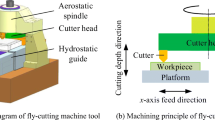Abstract
There was a serious cutting force disturbance in diamond-cutting microstructured surfaces with fast tool servo (FTS) resulting from their discontinuous profile. Although variable structure sliding mode control (VSSMC) strategy with exponential approaching law for FTS can suppress cutting force disturbance to a certain extent in machining process, high machined surface quality was hardly obtained because of the disadvantage of the exponential approaching law. A new VSSMC strategy with a combined approaching law for FTS was presented in this paper. A series of validating experiments were performed in unload and cutting situation respectively. The experimental results showed that the VSSMC with combined approaching law had an obvious advantage in FTS tracking performance over that with exponential approaching law. The system steady-state error was decreased from ±2 to ±0.5 %, and the system rise time was reduced from 2 to 0.8 ms. Measured results of the square-pit microstructured surfaces fabricated by two different strategies showed that a decrease of 10–30 % in the machined surface roughness and an improvement of more than 10 % in the profile accuracy were accomplished by the proposed strategy.
Similar content being viewed by others
References
Richter H, Misawa EA, Lucca DA, Lu H (2001) Modeling nonlinear behavior in a piezoelectric actuator. Precis Eng 25(2):128–137
Miller AC, Cuttino JF (1997) Performance evaluation and optimization of a fast tool servo for single point diamond turning machines. SPIE 3134:318–328
Kim H, Kim E (2003) Feed-forward control of fast tool servo for real-time correction of spindle error in diamond turning of flat surfaces. Int J Mach Tools Manuf 43(12):1177–1183
Wang HF, Hu DJ, Wan DP, Liu HB (2006) Hysteresis compensation for piezoelectric actuators in single-point diamond turning. SPIE 6149:341–347
Dang X, Tan Y (2005) An inner product-based dynamic neural network hysteresis model for piezoceramic actuators. Sens Actuat A Phys 121(2):535–542
Zhao L, Chen D, Kong H (1994) Neuron net control and its application in precision feed mechanism of machine tool driven by PZT. Proceedings of the IEEE International Conference on Industrial Technology. Shanghai, China
Tong Z, Tan Y, Zeng X (2005) Modeling hysteresis using hybrid method of continuous transformation and neural networks. Sens Actuat A Phys 19(1):254–262
Shieh HJ, Lin FJ, Huang PK, Teng LT (2004) Adaptive tracking control solely using displacement feedback for a piezo-positioning mechanism. IEE P Contr Theor Ap 151(5):653–660
Hwang CL, Chen YM, Jan C (2005) Trajectory tracking of large displacement piezoelectric actuators using a nonlinear observer-based variable structure control. IEEE T Contr Syst T 13(1):56–66
Chang T, Sun X (2001) Analysis and control of monolithic piezoelectric nanoactuator. IEEE T Contr Syst T 9(1):69–75
Song G, Zhao J, Zhou X, de Abreu-Garcia JA (2005) Tracking control of a piezoceramic actuator with hysteresis compensation using inverse Preisach model. IEEE ASME T Mech 10(2):198–209
Ru C, Sun L (2005) Improving positioning accuracy of piezoelectric actuators by feedforward hysteresis compensation based on a new mathematical model. Rev Sci Instrum 76(9):1–8
Goldfarb M, Celanovic N (1997) Modeling piezoelectric stack actuators for control of micro manipulation. IEEE Contr Syst Mag 17(3):69–79
Oh JH, Bernstein DS (2005) Semilinear Duhem model for rate-independent and rate-dependent hysteresis. IEEE T Automat Contr 50(5):631–645
Banning R, de Koning WL, Adriaens HJMTA, Koops RK (2001) State space analysis and identification for a class of hysteretic systems. Automatica 37(12):1883–1892
Janocha H, Kuhnen K (2000) Real-time compensation of hysteresis and creep in piezoelectric actuators. Sensor Actuat A Phys 79(2):83–89
Ge P, Jouaneh M (1997) Generalized Preisach model for hysteresis nonlinearity of piezoceramic actuators. Precis Eng 20(2):99–111
Li C, Tan Y (2004) A neural networks model for hysteresis nonlinearity. Sensor Actuat A Phys 112(1):49–54
Dang X, Tan Y (2005) Neural networks dynamic hysteresis model for piezoceramic actuator based on hysteresis operator of first-order differential equation. Physica B 365(1–4):173–184
Ge P, Jouaneh M (1995) Modeling hysteresis in piezoceramic actuators. Precis Eng 17(3):211–221
Yu Y, Xiao Z, Naganathan NG, Dukkipati RV (2002) Dynamic Preisach modelling of hysteresis for the piezoceramic actuator system. Mech Mach Theory 37(1):75–89
Schitter G, Stemmer A (2004) Identification and open-loop tracking control of a piezoelectric tube scanner for high-speed scanning-probe microscopy. IEEE T Contr Syst T 12(3):449–454
Sun L, Ru C, Rong W, Chen L, Kong M (2004) Tracking control of piezoelectric actuator based on a new mathematical model. J Micromech Microeng 14(11):1439–1444
Lv Y, Wei Y (2004) Study on open-loop precision positioning control of a micropositioning platform using a piezoelectric actuator. Proceedings of the 5th World Congress on Intelligent Control and Automation. Hangzhou, China
Hwang CL, Chen BS (1990) Constant turning force adaptive control via sliding mode control design. Trans ASME 112(2):308–312
Buckner GD (2001) Intelligent sliding mode control of cutting force during single-point turning operations. J Manuf Sci E-T ASME 123:206–213
Utkin VI (1977) Variable structure systems with sliding modes. IEEE T Automat Contr 22(2):212–222
Hung JY, Gao W, Hung JC (1993) Variable structure control: a survey. IEEE T Ind Electron 40(1):2–22
Zhang HJ, Chen SJ, Zhou M, Yang YH (2009) Fast tool servo control for diamond cutting microstructured optical components. J Vac Sci Technol B 27(3):1226–1229
Liu JK (2005) MATLAB simulation for sliding mode control. Tsinghua University Press, Beijing
Author information
Authors and Affiliations
Corresponding author
Rights and permissions
About this article
Cite this article
Zhang, H., Dong, G., Zhou, M. et al. A new variable structure sliding mode control strategy for FTS in diamond-cutting microstructured surfaces. Int J Adv Manuf Technol 65, 1177–1184 (2013). https://doi.org/10.1007/s00170-012-4249-2
Received:
Accepted:
Published:
Issue Date:
DOI: https://doi.org/10.1007/s00170-012-4249-2



